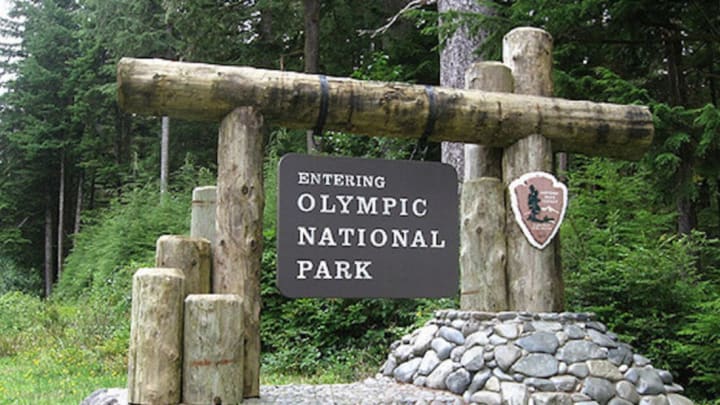10 Facts About Olympic National Park
By Megan Snyder

Located on the Olympic Peninsula in Washington state, Olympic National Park features one of the most unique collections of landscapes in a U.S. national park. This wilderness area offers over 3 million annual guests a look at old growth forests, glacier-covered mountain peaks, temperate rainforest, and over 70 miles of coastline. Here are a few facts to know about this natural wonder in the Pacific Northwest.
1. THE PARK HAS GROWN IN AREA AND STATUS SINCE THE LATE 19TH CENTURY.
The area that would eventually form Olympic National Park was originally preserved as Olympic Forest Reserve by President Grover Cleveland in 1897. It became Olympic National Forest in 1907. This evolved into Mount Olympus National Monument under President Theodore Roosevelt in 1909, before finally earning the designation of national park in 1938.
2. ROOSEVELT ELK WERE KEY IN THE PARK’S PRESERVATION.
Ken Lund, Flickr // CC BY-SA 2.0
Visitors are most likely to spot Roosevelt elk—named in honor of President Theodore Roosevelt—in Olympic’s rain forests. Overhunting nearly wiped out the elk in the late 1800s but the creation of Mount Olympus National Monument ensured that the animals would be protected and hopefully avoid extinction. In fact, protecting the elk was so important that, according to the National Park Service, Olympic was almost named Elk National Park.
3. YOU CAN VISIT MOUNT OLYMPUS WITHOUT TRAVELING TO GREECE.
Jonathan Miske, Flickr // CC BY-SA 2.0
At 7980 feet, Mount Olympus is the highest peak in Olympic National Park. It's also the highest point in the Olympic mountain range.
4. IT'S HOME TO ONE OF THE FEW TEMPERATE RAIN FORESTS IN THE WORLD.
Nagarajan Kanna, Flickr // CC BY-NC-ND 2.0
Olympic protects a region of the North America’s remaining temperate rain forests. Filled with mosses and Sitka spruce, the Hoh, Quinault, Queets, and Bogachiel river valleys all have characteristics of this ecosystem. In fact, the Hoh and Quinault Rain Forests are among the park’s most notable features.
5. UNUSUAL WEATHER SPARKED A RAIN FOREST FIRE IN 2015.
Considering that the Hoh Rain Forest receives 12 feet of rain annually, it might seem impossible for the area to catch on fire. However, 2015 was an unusual year for precipitation. When minimal snowpack from the previous winter was followed by the driest spring in over a century, Olympic was more susceptible to fire than ever. A lightning strike in the drought-stricken forest resulted in what became known as the Paradise Fire, which burned from the beginning of June through September.
6. HURRICANE RIDGE IS A POPULAR DESTINATION YEAR-ROUND.
TravelingOtter, Flickr // CC BY-SA 2.0
Earning its name from the winds that whip through the area at 70 mph and above, Hurricane Ridge is one of the most popular spots in Olympic National Park. Summer hikes offer striking views of the Olympic Mountains and a chance to spot Pacific Northwest wildlife. The heavy snowpack through much of the year makes it an ideal place for skiing and snowboarding, which is largely overseen by Hurricane Ridge Ski and Snowboard Area—one of the few lift service ski areas located in a U.S. national park.
7. THE OLYMPIC MARMOT IS ONE OF THE PARK’S FEW ENDEMIC ANIMALS.
Helen Rickard, Flickr // CC BY-SA 2.0
Native to the area, the Olympic marmot is one of the endemic species you might spot on a visit to the park. These animals weigh between 8 to 20 pounds and communicate by whistling. Having adapted to the mountain environment, the park’s marmots can hibernate up to two-thirds of the year [PDF].
8. ONCE USED FOR HYDROPOWER, THE ELWHA RIVER NOW RUNS WILD.
claumoho, Flickr // CC BY 2.0
Known for its incredible variety of fish, the powerful Elwha River is a prominent and formerly controversial feature in the park. Two dams were constructed on the river in the early 20th century to supply power to local milling operations. While harnessing hydropower helped the economy, it created several negative environmental effects. The Elwha River Ecosystem and Fisheries Restoration Act was passed in 1992 and by 2014, both the Elwha and Gilnes Canyon Dam had been removed in the largest dam removal project in U.S. history.
9. A COASTAL LOOKOUT PROGRAM WAS ESTABLISHED DURING WORLD WAR II.
Coast guard stations were established on Olympic’s beaches during World War II, because of its highly vulnerable location on the Olympic Peninsula. If an attack were to come from the Pacific, the peninsula was one of the most obvious choices for entry. The strategically placed stations didn’t see much action, although a Russian shipwreck in 1943 stirred up some excitement at the station near La Push.
10. ANCIENT DRAWINGS CAN BE FOUND ON A POPULAR BEACH HIKE.
Miguel Vieira, Flickr // CC BY 2.0
Visitors can make the most of their Olympic experience by hiking the Ozette Triangle trail and visiting Wedding Rocks, a rocky outcropping on the coastline that showcases drawings carved into the rock. The carvings of whales, hunters, and other symbols are called petroglyphs and were left by the Makah tribe.